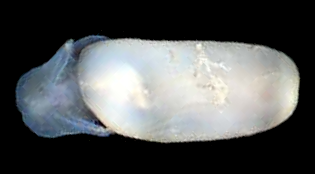
Sea slug is a common name for some marine invertebrates with varying levels of resemblance to terrestrial slugs. Most creatures known as sea slugs are gastropods, i.e. they are sea snails that, over evolutionary time, have either entirely lost their shells or have seemingly lost their shells due to having a significantly reduced or internal shell. The name "sea slug" is often applied to nudibranchs and a paraphyletic set of other marine gastropods without apparent shells.

Aplysiidae is the only family in the superfamily Aplysioidea, within the clade Anaspidea. These animals are commonly called sea hares because, unlike most sea slugs, they are often quite large, and when they are underwater, their rounded body shape and the long rhinophores on their heads mean that their overall shape resembles that of a sitting rabbit or hare. Sea hares are however sea snails with shells reduced to a small plate hidden between the parapodia, and some species are extremely large. The Californian black sea hare, Aplysia vaccaria is arguably the largest living gastropod species, and is certainly the largest living heterobranch gastropod.

Bulla is a genus of medium to large hermaphrodite sea snails, shelled marine opisthobranch gastropod molluscs. These herbivorous snails are in the suborder Cephalaspidea, headshield slugs, and the order Opisthobranchia.

The Pleurobranchidae are a taxonomic family of sea slugs, marine gastropod molluscs in the clade Pleurobranchomorpha.

Glossodoris is a genus of sea slugs, dorid nudibranchs, shell-less marine gastropod mollusks in the family Chromodorididae.

Doris is a genus of sea slugs, specifically dorid nudibranchs. These animals are marine gastropod molluscs in the family Dorididae.
Kikutaro Baba was a Japanese malacologist. He was the leading researcher on sea slugs and bubble snails, opisthobranch gastropod mollusks in Japan.

Goniodoris is a genus of sea slugs, specifically dorid nudibranchs, marine gastropod molluscs in the family Goniodorididae.

Berthella is a genus of sea slugs, marine gastropod mollusks in the family Pleurobranchidae.

Felimida is a genus of sea slugs, dorid nudibranchs, shell-less marine gastropod mollusks in the family Chromodorididae.

Felimare is a genus of sea slugs, dorid nudibranchs, shell-less marine gastropod molluscs in the subfamily Miamirinae of the family Chromodorididae.

Retusa is a genus of very small head-shield sea snails or barrel-bubble snails, marine gastropod molluscs in the family Retusidae.

Frank Mace MacFarland (1869–1951) was an American malacologist associated with Stanford University in California. Born in Centralia, Illinois, MacFarland attended DePauw University, Stanford University and the University of Wurzburg. On August 27, 1902, MacFarland married Olive Knowles Hornbrook. Mrs. MacFarland was a skilled technician and artist whose delicate watercolor paintings illustrated many of his scientific publications.

Philine quadripartita is a species of sea slugs or sea snails, marine gastropod molluscs that has in recent times been referred to as Philine aperta in the North East Atlantic, but several recent studies studying anatomical traits such as the reproductive anatomy and DNA has shown that P. quadripartita and P. aperta are two distinct species.












